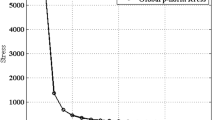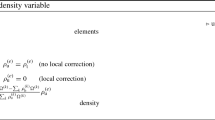Abstract
Soft materials are finding widespread implementation in a variety of applications, and it is necessary for the structural design of such soft materials to consider the large nonlinear deformations and hyperelastic material models to accurately predict their mechanical behavior. In this paper, we present an effective modified evolutionary topology optimization (M-ETO) method for the design of hyperelastic structures that undergo large deformations. The proposed M-ETO method is implemented by introducing the projection scheme into the evolutionary topology optimization (ETO) method. This improvement allows nonlinear topology optimization problems to be solved with a relatively big evolution rate, which significantly enhances the robustness. The minimal length scale is achieved as well. Numerical examples show that the proposed M-ETO method can stably obtain a series of optimized structures under different volume fractions with smooth boundaries. Moreover, compared with other smooth boundary methods, another merit of M-ETO is that the problem of the dependency on initial layout can be eliminated naturally due to the inherent characteristic of ETO.














Similar content being viewed by others
References
Abdi M, Ashcroft I, Wildman R (2018) Topology optimization of geometrically nonlinear structures using an evolutionary optimization method. Eng Optim 50:1850–1870. https://doi.org/10.1080/0305215X.2017.1418864
Allaire G, Jouve F, Toader AM (2004) Structural optimization using sensitivity analysis and a level-set method. J Comput Phys 194:363–393. https://doi.org/10.1016/j.jcp.2003.09.032
Ball JM (1976) Convexity conditions and existence theorems in nonlinear elasticity. Arch Ration Mech Anal 63:337–403. https://doi.org/10.1007/BF00279992
Bendsøe MP, Kikuchi N (1988) Generating optimal topologies in structural design using a homogenization method. Comput Methods Appl Mech Eng 71:197–224
Bendsøe MP, Sigmund O (2004) Topology optimization theory, methods and applications, Second Edi. Springer-Verlag Berlin Heidelberg GmbH
Bensøe MP (1995) Optimization of structural topology, shape, and material, first edit. Springer-Verlag, Berlin Heidelberg GmbH
Bruns TE, Tortorelli DA (2003) An element removal and reintroduction strategy for the topology optimization of structures and compliant mechanisms. Int J Numer Methods Eng 57:1413–1430. https://doi.org/10.1002/nme.783
Bruns TE, Tortorelli DA (1998) Topology optimization of geometrically nonlinear structures and compliant mechanisms. 7th AIAA/USAF/NASA/ISSMO Symp Multidiscip Anal Optim 1874–1882. https://doi.org/10.2514/6.1998-4950
Bruns TE, Tortorelli DA (2001) Topology optimization of non-linear elastic structures and compliant mechanisms. Comput Methods Appl Mech Eng 190:3443–3459. https://doi.org/10.1016/S0045-7825(00)00278-48
Buhl T, Pedersen CBW, Sigmund O (2000) Stiffness design of geometrically nonlinear structures using topology optimization. Struct Multidiscip Optim 19:93–104. https://doi.org/10.1007/s001580050089
Chen F, Wang Y, Wang MY, Zhang YF (2017) Topology optimization of hyperelastic structures using a level set method. J Comput Phys 351:437–454. https://doi.org/10.1016/j.jcp.2017.09.040
Chen Q, Zhang X, Zhu B (2018) Topology optimization of fusiform muscles with a maximum contraction. Int j numer method biomed eng 34:1–26. https://doi.org/10.1002/cnm.3096
Chi H, Ramos DL, Ramos AS, Paulino GH (2019) On structural topology optimization considering material nonlinearity: plane strain versus plane stress solutions. Adv Eng Softw 131:217–231. https://doi.org/10.1016/j.advengsoft.2018.08.017
Crisfield MA, de Borst R, Remmers JJC, Verhoosel CV (1991) Non-linear finite element analysis of solids and structures. Wiley
Da D, Xia L, Li G, Huang X (2018) Evolutionary topology optimization of continuum structures with smooth boundary representation. Struct Multidiscip Optim 57:2143–2159. https://doi.org/10.1007/s00158-018-2090-4
Deng H, Cheng L, To AC (2019) Distortion energy-based topology optimization design of hyperelastic materials. Struct Multidiscip Optim 59:1895–1913. https://doi.org/10.1007/s00158-018-2161-6
Guest JK, Prévost JH, Belytschko T (2004) Achieving minimum length scale in topology optimization using nodal design variables and projection functions. Int J Numer Methods Eng 61:238–254. https://doi.org/10.1002/nme.1064
Ha SH, Cho S (2008) Level set based topological shape optimization of geometrically nonlinear structures using unstructured mesh. Comput Struct 86:1447–1455. https://doi.org/10.1016/j.compstruc.2007.05.025
Huang X, Xie YM (2007) Bidirectional evolutionary topology optimization for structures with geometrical and material nonlinearities. AIAA J 45:308–313. https://doi.org/10.2514/1.25046
Huang X, Xie YM (2008) Topology optimization of nonlinear structures under displacement loading. Eng Struct 30:2057–2068. https://doi.org/10.1016/j.engstruct.2008.01.009
Jog C (1996) Distributed-parameter optimization and topology design for non-linear thermoelasticity. Comput Methods Appl Mech Eng 132:117–134. https://doi.org/10.1016/0045-7825(95)00990-6
Kang Z, Luo Y (2009) Non-probabilistic reliability-based topology optimization of geometrically nonlinear structures using convex models. Comput Methods Appl Mech Eng 198:3228–3238. https://doi.org/10.1016/j.cma.2009.06.001
Klarbring A, Strömberg N (2013) Topology optimization of hyperelastic bodies including non-zero prescribed displacements. Struct Multidiscip Optim 47:37–48. https://doi.org/10.1007/s00158-012-0819-z
Kwak J, Cho S (2005) Topological shape optimization of geometrically nonlinear structures using level set method. Comput Struct 83:2257–2268. https://doi.org/10.1016/j.compstruc.2005.03.016
Lahuerta RD, Simões ET, Campello EMB et al (2013) Towards the stabilization of the low density elements in topology optimization with large deformation. Comput Mech 52:779–797. https://doi.org/10.1007/s00466-013-0843-x
Li Y, Zhu J, Wang F et al (2019) Shape preserving design of geometrically nonlinear structures using topology optimization. Struct Multidiscip Optim 59:1033–1051. https://doi.org/10.1007/s00158-018-2186-x
Luo Y, Li M, Kang Z (2016) Topology optimization of hyperelastic structures with frictionless contact supports. Int J Solids Struct 81:373–382. https://doi.org/10.1016/j.ijsolstr.2015.12.018
Luo Y, Wang MY, Kang Z (2015) Topology optimization of geometrically nonlinear structures based on an additive hyperelasticity technique. Comput Methods Appl Mech Eng 286:422–441. https://doi.org/10.1016/j.cma.2014.12.023
Luo Z, Tong L (2008) A level set method for shape and topology optimization of large-displacement compliant mechanisms. Int J Numer Methods Eng 76:862–892. https://doi.org/10.1002/nme.2352
Pedersen CBW, Buhl T, Sigmund O (2001) Topology synthesis of large-displacement compliant mechanisms. Int J Numer Methods Eng 50:2683–2705. https://doi.org/10.1002/nme.148
Querin OM, Steven GP, Xie YM (1998) Evolutionary structural optimisation (ESO) using a bidirectional algorithm. Eng Comput (Swansea, Wales) 15:1031–1048. https://doi.org/10.1108/02644409810244129
Shobeiri V (2020) Bidirectional evolutionary structural optimization for nonlinear structures under dynamic loads. Int J Numer Methods Eng 121:888–903. https://doi.org/10.1002/nme.6249
Sigmund O (2001) A 99 line topology optimization code written in matlab. Struct Multidiscip Optim 21:120–127. https://doi.org/10.1007/s001580050176
Sigmund O, Maute K (2013) Topology optimization approaches: a comparative review. Struct Multidiscip Optim 48:1031–1055. https://doi.org/10.1007/s00158-013-0978-6
Van Dijk NP, Maute K, Langelaar M, Van Keulen F (2013) Level-set methods for structural topology optimization: a review. Struct Multidiscip Optim 48:437–472. https://doi.org/10.1007/s00158-013-0912-y
Wallin M, Ristinmaa M (2015) Topology optimization utilizing inverse motion based form finding. Comput Methods Appl Mech Eng 289:316–331. https://doi.org/10.1016/j.cma.2015.02.015
Wang F, Lazarov BS, Sigmund O, Jensen JS (2014) Interpolation scheme for fictitious domain techniques and topology optimization of finite strain elastic problems. Comput Methods Appl Mech Eng 276:453–472. https://doi.org/10.1016/j.cma.2014.03.021
Xia L, Xia Q, Huang X, Xie YM (2018) Bi-directional evolutionary structural optimization on advanced structures and materials: a comprehensive review. Arch Comput Methods Eng 25:437–478. https://doi.org/10.1007/s11831-016-9203-2
Xie YM, Steven GP (1993) A simple evolutionary procedure for structural optimization. Comput Struct 49:885–896
Xu B, Han Y, Zhao L (2020) Bi-directional evolutionary topology optimization of geometrically nonlinear continuum structures with stress constraints. Appl Math Model 80:771–791. https://doi.org/10.1016/j.apm.2019.12.009
Yoon GH, Kim YY (2005) Element connectivity parameterization for topology optimization of geometrically nonlinear structures. Int J Solids Struct 42:1983–2009. https://doi.org/10.1016/j.ijsolstr.2004.09.005
Zienkiewicz OC, Taylor RL (2005) The finite element method for solid and structural mechanics, 6th ed. Elsevier Butterworth-Heinemann
Funding
This work was supported in part by the National Natural Science Foundation of China under Grant Nos. 51675525 and 11725211.
Author information
Authors and Affiliations
Corresponding author
Ethics declarations
Conflict of interest
The authors declare that they have no conflict of interest.
Replication of results
The proposed framework is built on the projection scheme and the original evolutionary topology optimization method; the combination of which has been fully expounded in this work. The results can be easily reproduced. Moreover, the opening of the source code of the proposed method is banned by a project.
Additional information
Responsible Editor: Emilio Carlos Nelli Silva
Publisher’s note
Springer Nature remains neutral with regard to jurisdictional claims in published maps and institutional affiliations.
Appendix
Appendix
The matrices BN BL BNL G used in (21) and (25) are defined as follows, here take the four-node element as an example:


Rights and permissions
About this article
Cite this article
Zhang, Z., Zhao, Y., Du, B. et al. Topology optimization of hyperelastic structures using a modified evolutionary topology optimization method. Struct Multidisc Optim 62, 3071–3088 (2020). https://doi.org/10.1007/s00158-020-02654-9
Received:
Revised:
Accepted:
Published:
Issue Date:
DOI: https://doi.org/10.1007/s00158-020-02654-9




